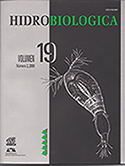Paralytic toxins in bivalve mollusks during a proliferation of Gymodinium catenatum Graham in Bahía de La Paz, Mexico
Keywords:
Bahía de La Paz, Gymnodinium catenatum, mollusks, harmful algae, paralytic toxins.Abstract
From February to March 2007 a harmful algae bloom of Gymnodinium catenatum Graham ocurred in Bahía de La Paz, Mexico, with cell densities from 6 x 105 to 2,39 x 106 cells L-1. During this event the toxin concentration and toxin profile of paralytic shellfish toxins in mollusks (Pinna rugosa, Modiolus capax, Megapitaria squalida, Periglypta multicostata, Dosinia ponderosa, and Megapitaria aurantiaca), and in phytoplankton samples were determined. Some physicochemical data were obtained. The average values of the surface temperature and dissolved oxygen were 20.9 ± 0.7 °C and 6.9 ± 0.3 mg L-1. The average concentrations of nitrites, nitrates, ammonium, phosphates, and silicates were 0.22 ± 0.05, 1.04 ± 0.33, 0.89 ± 0.88, 0.81 ± 0.76, and 8.85 ± 1.60 µM, respectively. The concentration of paralytic shellfish toxins in the net phytoplankton samples varied from 4.32 to 79.60 ng saxitoxin equivalents filter-1, identifying 8 toxins, the most abundant being C1 and C2. The highest toxin concentration found in mollusks were 31.14, 37.74, and 25.89 µg STXeq 100 g-1 in M. capax, P. rugosa, and M. aurantiaca, respectively. The variations in the paralytic toxin profile in the different mollusks species are given.Downloads
Downloads
Published
How to Cite
Issue
Section
License
Los autores/as que publiquen en esta revista aceptan las siguientes condiciones:
De acuerdo con la legislación de derechos de autor, HIDROBIOLÓGICA reconoce y respeta el derecho moral de los autores, así como la titularidad del derecho patrimonial, el cual será cedido a la revista para su difusión en acceso abierto.
Publicar en la revista HIDROBIOLÓGICA tiene un costo de recuperación de $500 pesos mexicanos por página en blanco y negro (aproximadamente 29 dólares americanos) y $1000 pesos por página a color (aproximadamente 58 dólares americanos).
Todos los textos publicados por HIDROBIOLÓGICA sin excepción se distribuyen amparados bajo la licencia Creative Commons 4.0Atribución-No Comercial (CC BY-NC 4.0 Internacional), que permite a terceros utilizar lo publicado siempre que mencionen la autoría del trabajo y a la primera publicación en esta revista.
Los autores/as pueden realizar otros acuerdos contractuales independientes y adicionales para la distribución no exclusiva de la versión del artículo publicado en HIDROBIOLÓGICA (por ejemplo incluirlo en un repositorio institucional o publicarlo en un libro) siempre que indiquen claramente que el trabajo se publicó por primera vez en HIDROBIOLÓGICA.
Para todo lo anterior, el o los autor(es) deben remitir el formato de Carta-Cesión de la Propiedad de los Derechos de la primera publicación debidamente requisitado y firmado por el autor(es). Este formato se puede enviar por correo electrónico en archivo pdf al correo: enlacerebvistahidrobiológica@gmail.com; rehb@xanum.uam.mx (Carta-Cesión de Propiedad de Derechos de Autor).
Esta obra está bajo una licencia de Creative Commons Reconocimiento-No Comercial 4.0 Internacional.


